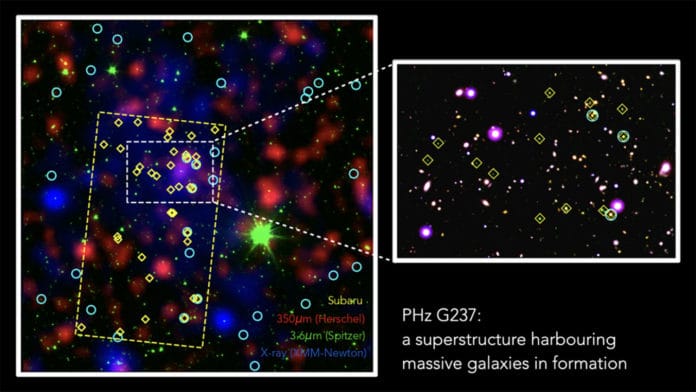An international team of astronomers recently discovered a galaxy shipyard- a structure thought to be a “protocluster” of galaxies on its way to developing into a galaxy supercluster- almost 11 billion light-years from Earth. This group of objects appears to be an emerging accumulation of galaxies.
The discovery of this galaxy shipyard could offer a detailed understanding of the assembly of galaxy clusters, the most massive structures in the universe.
Brenda Frye, an associate professor of astronomy at the University of Arizona‘s Steward Observatory, said, “We still know very little about protoclusters, in part because they are so faint, too faint to be detected by optical light. At the same time, they are known to radiate brightly in other wavelengths such as the sub-millimeter.”
This protocluster was originally discovered by the European Space Agency’s Planck telescope as part of an all-sky survey. This study showed the protocluster in the far-infrared region of the electromagnetic spectrum.
While looking through the sample of more than 2,000 structures that could be in the process of becoming clusters, astronomers came across a protocluster called PHz G237.01+42.50, or G237.
Further observations were needed to confirm its identity. Using the Large Binocular Telescope’s combined power in Arizona and the Subaru Telescope in Japan, the team observed 63 galaxies belonging to the G237 protocluster.
Frye said, “You can think of galaxy protoclusters such as G237 as a galaxy shipyard in which massive galaxies are being assembled, only this structure existed at a time when the universe was 3 billion years old. At the same time, the genealogy may be closer than you think. Because the universe is homogeneous and the same in all directions, we think that the Milky Way may have docked at a protocluster node similar to G237 when it was very young.”
Observations reveal that the star formation in G237 was unrealistically high- at a rate of 10,000 times that of the Milky Way. With such rates, the protocluster would be expected to rapidly use up its stellar fuel and subsequently settle down into a complex system similar to the Virgo supercluster.
Frye said, “Each of the 63 galaxies discovered so far in G237 was like a star factory in overdrive. It’s as if the galaxies were working on overtime to the assembled stars. The rate of production was unsustainable. At such a pace, the supply chains are expected to break shortly, and in a way that permanently shuts down the galaxy shipyard.”
Later, the team discovered that some of what it was seeing came from galaxies unrelated to the protocluster. Still, even after the irrelevant observations were removed, the total star formation rate remained high, at least 1,000 solar masses per year, according to Polletta. In comparison, the Milky Way produces about one solar mass each year.
Frye said, “The picture we have pieced together now is that of a successful galaxy shipyard, which is working at high efficiency to assembling galaxies and the stars within them and has an energy supply that is more sustainable.”
“We believe that the filaments mediate the transfer of hydrogen gas from the diffuse medium of intergalactic space onto these hungry, newly forming protocluster structures in the nodes.”
Mari Polletta at the National Institute for Astrophysics in Milan, Italy, said, “Pointing to future research, we are in the process of analyzing more observations on this and other Planck protoclusters to trace the gas that gives birth to these newly forming stars and feeds the supermassive black holes, to determine its origin and explain the observed extraordinary activity.”
Frye said, “We are looking forward to combining data from the Large Binocular Telescope with observations from NASA’s the James Webb Space Telescope, to be launched in December.”
“Protoclusters offer an opportunity to investigate key questions in astronomy that only this new observatory can answer, such as what mechanisms drive the prodigious star formation, and when will the hydrogen supply run out, forcing this galaxy shipyard to close its doors and turn into a supercluster similar to the one our Milky Way is in?”
Journal Reference:
- M. Polletta, G. Soucail et al. Spectroscopic observations of PHz G237.01+42.50: A galaxy protocluster at z = 2.16 in the Cosmos field⋆. DOI: 10.1051/0004-6361/202140612
